|
Monitoring of Cabin Control
Climate with intelligent cooling control of Fan Coil units and damper
control in supply air duct from Air Handling Unit. |
|
|
|
|
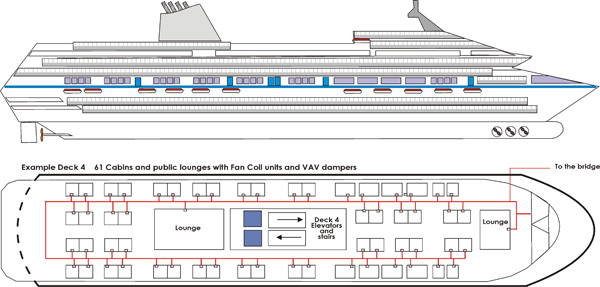 |
|
|
|
|
Cooling demand control with Fan Coil cooling unit
and VAV (Iris) damper control.
The MPC Cabin Controller
is an intelligent room controller that includes different special
features such as, built-in sensor for measuring of temperature and input
for occupancy detector, outputs 0-10V for damper control and PWM output
for thermal valve actuator, as well as relay outputs for fan control.
The temperature settings are made by pressing the
left setpoint button for warmer and the right button for colder
temperature.
The temperature settings and the setpoint can be
shown on the display.
The fan speed is controlled with relay outputs in
three steps.
Speed levels, Low-Medium-High, are shown on the
display.
The fan speed is automatic or manually controlled
with the buttons (FAN) on the controller.
Programmed with PI-loops, the cabin controller
activates the supply air damper as well as the Fancoil cooler, according to
passenger setpoint demands.
The MPC 5G Cabin Controller has a built-in fieldbus
protocol with MODBUS RTU for network communication.
|
|
|
|
|
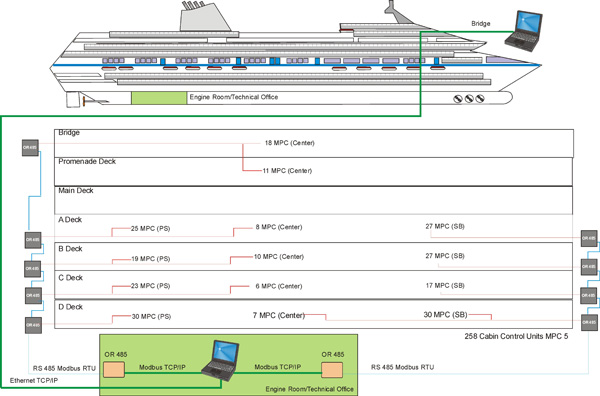 |
|
|
|
|
Operation
Energy conservation
To conserve energy and improve passenger comfort,
the automatic reset will return to the original setpoint minus 2 degrees,
when the time limit is exceeded by the occupancy detector.
When the cabin is unoccupied the controller is
set to a minimum cooling mode. |
|
|
|
|
 |
|
|
|
|
Operation Panel
The temperature sensor ST1 regulates via MPC 5G,
an air damper DA22 VAV1 (Irisdamper) and a valve actuator VA 11 on
the Fancoil-Cooling Unit in sequence at cooling demand.
With increasing temperature the damper actuator
opens for cool air in the supply duct.
If the demand for cooling is still preset at max. cooling in the cabin, the valve VA11 for Fancoil cooling opens, to
keep the setpoint temperature.
With decreasing temperature the reverse
condition will appear. |
|
|
|
|
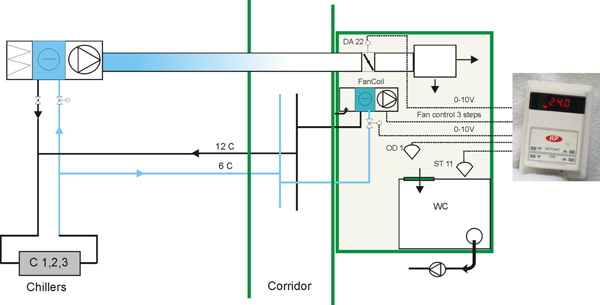 |
|
|
|
|
Control signals to the damper actuator are 0-10V and
the thermal valve actuator is controlled by PWM (Pulse Width
Modulation). Control signals to are relayed to outputs in three steps.
For the monitoring and surveillace of regulation
with the MPC Cabin Controller, an operator panel will be installed, at
the technical office, providing the ship´s staff full control of the
cooling and ventilation system in the cabins.
The operation panel has a Modbus RTU protocol for
communication, and Ethernet for TCP/IP communication via the ship´s
network for monitoring at the bridge. |
|
|
|
|
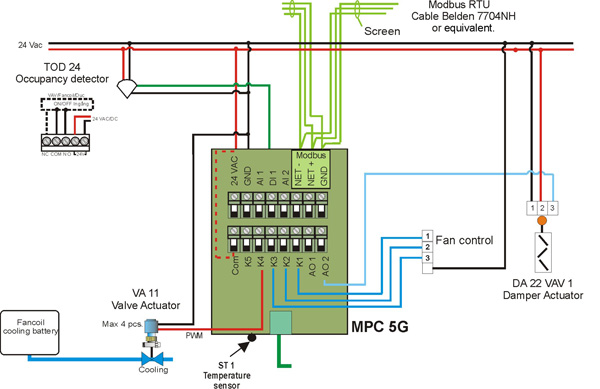 |
|
|
|
|
|
|
|
|
The Queen of Mälaren, M / S Lady Hutton,
Stockholm
The Queen of Mälaren is one of Stockholm's most unique hotels.
Since 1982 She has been moored to Riddarholmen, a stone's throw from
Stockholm City.
When you enter the gangway, you follow in the footsteps of many famous
movie stars, politicians and royalty. You stay in cabins with all the
best comforts a hotel can offer.
There are 61 cabins, spread on 3 decks, a conference room which seats 15
and a gourmet restaurant.
Entering the hotel the first thing the guest will notice is the pleasant
indoor climate.
This first impression is an important part of the satisfaction
experience at the Hotel.
The challenge
In the past, the employees often received complaints from the guests
regarding the climate in the cabins.
The staff were frustrated because they wanted to do their best for the
guests, but the system in place at the time had mechanical deficiencies
as well as being difficult to manage since there was no central
monitoring system.
The hotel management contacted a mechanical
contractor who turned to Automatikprodukter, which through its partner
Regmo (System Integrator) carried out an inspection on site. Regmo
identified a number of problems in the hotel and presented several
alternatives for "The Queen of Mälaren."
-
Many of the cabins had insufficient
ventilation due to inaccurate air flow measurements during the most
recent commissioning.
-
In addition, many of the heating valves
needed replacing.
-
The documentation and drawings of the control
system were out of date and incomplete.
-
There were deficiencies with the design of
the ventilation system which also contributed to the problems.
-
The hotel management wanted an easy way for
the staff to monitor & control the system.
|
 |
|
|
|
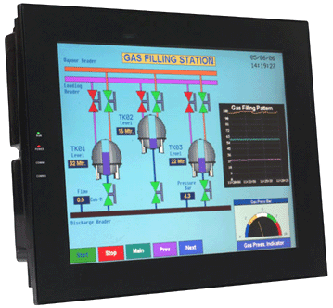 |
|
|
|
 |
|
The solution
For the central equipment, an IP-DDC-controller was installed.
Zone control is taken care of by controllers from AP, these use an open
Modbus protocol.
Operator interface is via a sophisticated operator panel and alarm
indication on the cabinet, provides the hotel's staff full control of
ventilation and heating.
All equipment is CE certified.
Finally, all the systems and solutions were well documented which will
speed up system troubleshooting in the future.
Hotel staff can now monitor and control the total energy use, thereby
reducing energy costs.
The knowledge and skills of Regmo, contributed to maintain the high
standards of the hotel and also to satisfy the requirements of the
guests.
The solution provides central monitoring of a well documented system to
operating staff who can now identify problems and fix them before they
become guest complaints.
The efficiency of the system is constantly monitored and faults can be
identified before they show up on the energy bills. |
|
|
On the M/S Queen Mary 2,
humidity is measured with HOT moisture sensors
The largest and most luxurious passenger ship of our time uses AP's
moisture sensor for best comfort.
This technology is used in order to give 2620 passengers a good indoor
climate in cabins, 14 bars, eight is kitchens, etc.
The sensors can withstand aggressive salt environments and high moisture
content for their cruises in the Caribbean for example.
The ship with its 345 meters can be compared with the Finland ferries of
200 meters or the Titanic of 269 meters.
The vessel has a top speed of around 30 knots. |
 |
|
|
|
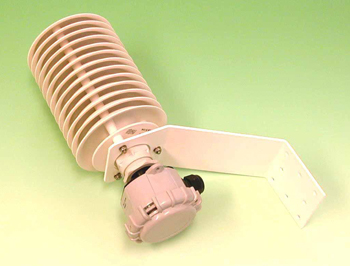 |
|
|
|